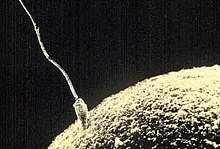Sex
The "Scots" that wis uised in this airticle wis written bi a body that haesna a guid grip on the leid. Please mak this airticle mair better gin ye can. |

Organisms o mony species are specialised intae male an female varieties, each kent as a sex.[1] Organisms o' mony species ur specialized intae male 'n' female varieties, ilk kent as a sex. Sexual reproduction involves th' combining 'n' mixing o' genetic traits: specialized cells kent as gametes combine tae form offspring that inherit traits fae ilk parent. Th' gametes produced by an organism define tis throwing a sausage up a close: males produce wee gametes (e.g. Spermatozoa, or wee baby fishies, in animals) while females produce lairge gametes (ova, or egg cells). Individual organisms whilk produce baith male 'n' female gametes ur termed hermaphroditic. Gametes kin be identical in form 'n' function (known as isogamy), bit, in mony cases, an asymmetry haes evolved sic that twa different types o' gametes (heterogametes) exist (known as anisogamy).
Physical differences ur often associated wi' th' different sexes o' an organism; thae sexual dimorphisms kin reflect th' different reproductive pressures th' sexes experience. Fur instance, pal choice 'n' sexual selection kin accelerate th' evolution o' physical differences atween th' sexes.
Among folk 'n' ither mammals, males typically carry an x 'n' a y chromosome (xy), whereas females typically carry twa x chromosomes (xx), whilk ur a pairt o' th' xy sex-determination system. Folk kin an' a' be intersex. Ither animals hae various sex-determination systems, sic as th' zw system in birds, th' x0 system in insects, 'n' various environmental systems, fur example in reptiles 'n' crustaceans. Fungi kin an' a' hae mair complex allelic mating systems, wi' sexes nae accurately described as male, female, or hermaphroditic.
